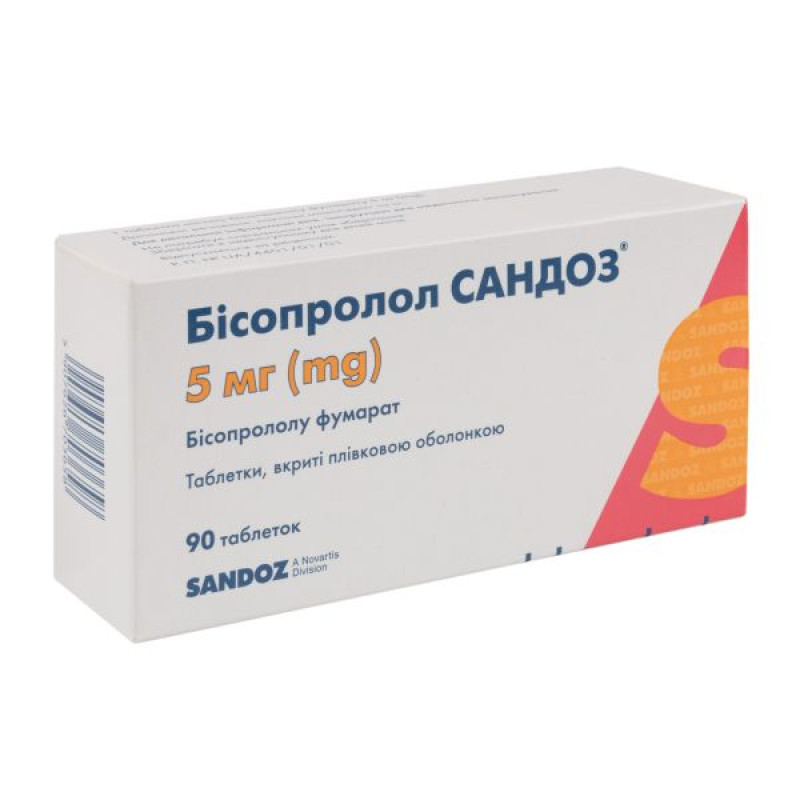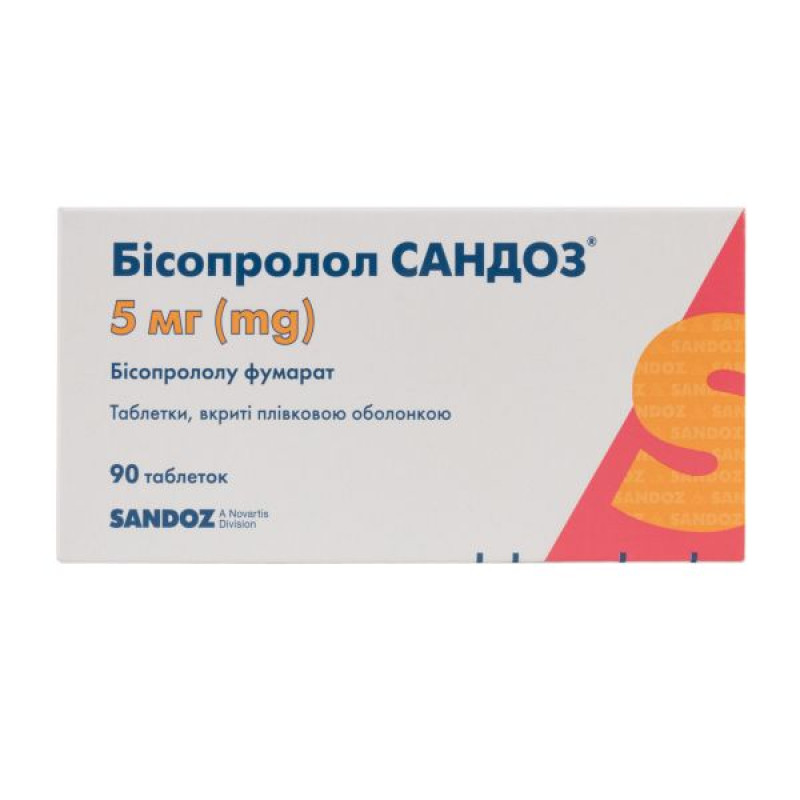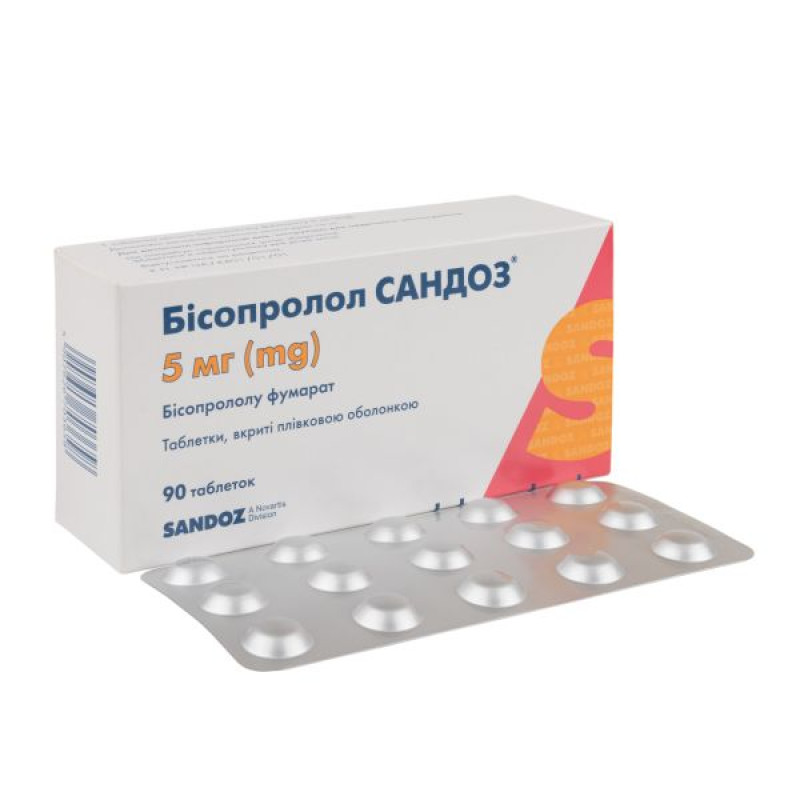Bisoprolol Sandoz film-coated tablets 5 mg blister No. 90

Instructions Bisoprolol Sandoz film-coated tablets 5 mg blister No. 90
Composition
active ingredient: bisoprolol fumarate;
1 tablet contains 5 mg or 10 mg of bisoprolol fumarate;
excipients: calcium hydrogen phosphate anhydrous, microcrystalline cellulose, pregelatinized corn starch, croscarmellose sodium, colloidal anhydrous silicon dioxide, magnesium stearate;
film coating for 5 mg tablets: colorless coating (lactose monohydrate, hypromellose, titanium dioxide (E 171), macrogol 4000), iron oxide yellow (E 172);
film coating for 10 mg tablets: colorless coating (lactose monohydrate, hypromellose, titanium dioxide (E 171), macrogol 4000), yellow iron oxide (E 172), red iron oxide (E 172).
Dosage form
Film-coated tablets.
Main physicochemical properties:
5 mg tablets: yellow, round, film-coated tablets, scored for division into four parts, embossed with “BIS5” on one side;
10 mg tablets: apricot-colored, round, film-coated tablets with a “snap tab” score for dividing into four parts, embossed with “BIS10” on one side.
Pharmacotherapeutic group
Selective β-adrenergic blockers. ATC code C07A B07.
Pharmacological properties
Pharmacodynamics
Bisoprolol is a highly selective β1-adrenergic blocker. When used in therapeutic doses, it does not have intrinsic sympathomimetic activity and clinically pronounced membrane-stabilizing properties. It has antianginal and hypotensive effects. In the treatment of patients with ischemic heart disease (IHD) without chronic heart failure, bisoprolol reduces myocardial oxygen demand by reducing heart rate and cardiac output and lowering blood pressure, and increases myocardial oxygen supply by reducing end-diastolic pressure and prolonging diastole. The drug has a very low affinity for β2-receptors of bronchial and vascular smooth muscle, as well as for β2-receptors of the endocrine system. The drug can only in rare cases affect bronchial and peripheral arterial smooth muscle, as well as glucose metabolism.
Bisoprolol does not have a pronounced negative inotropic effect.
The maximum effect of bisoprolol is achieved 3–4 hours after oral administration. With a single dose, the effect of bisoprolol persists for 24 hours. The maximum antihypertensive effect of bisoprolol is usually achieved after 2 weeks.
Pharmacokinetics
Absorption. After oral administration, bisoprolol is well absorbed from the gastrointestinal tract. Bioavailability is approximately 90% and is independent of food intake. The pharmacokinetics of bisoprolol and plasma concentrations are linear in the dose range from 5 mg to 20 mg. The maximum plasma concentration (Cmax) is reached after 2–3 hours.
Distribution: Plasma protein binding is approximately 30%, volume of distribution is 3.5 L/kg, and total clearance is approximately 15 L/kg.
Metabolism and elimination. The plasma half-life is 10–12 hours. Bisoprolol is eliminated from the body by two equivalent pathways – 50% of the active substance is converted to inactive metabolites in the liver and excreted by the kidneys, 50% is excreted by the kidneys unchanged. In vitro studies using human liver microsomes have shown that bisoprolol is metabolized with the participation of CYP3A4 (95%), CYP2D6 plays only a minor role. Dose adjustment for patients with mild to moderate hepatic or renal impairment is not required. The pharmacokinetics of bisoprolol are linear and do not depend on the patient’s age.
Indication
Arterial hypertension, ischemic heart disease (CHD) (angina pectoris), chronic heart failure (CHF) with left ventricular systolic dysfunction in combination with ACE inhibitors, diuretics, and if necessary, cardiac glycosides.
Contraindication
Hypersensitivity to bisoprolol or to other components of the drug;
acute heart failure or heart failure in a state of decompensation requiring inotropic therapy;
cardiogenic shock;
atrioventricular block II and III degree (except in patients with an artificial pacemaker);
sick sinus syndrome;
severe sinoatrial block;
symptomatic bradycardia (heart rate less than 60 beats/min);
symptomatic arterial hypotension (systolic blood pressure below 100 mm Hg);
severe chronic obstructive pulmonary disease;
severe form of bronchial asthma;
late stages of peripheral circulatory disorders, Raynaud's disease;
untreated pheochromocytoma;
metabolic acidosis;
simultaneous use with floctafenine and sultopride.
Interaction with other medicinal products and other types of interactions
Combinations that are not recommended for use.
Treatment of chronic heart failure.
Class I antiarrhythmics (e.g. quinidine, disopyramide, lidocaine, phenytoin, flecainide, propafenone): negative effect on atrioventricular conduction and myocardial inotropic function.
Calcium antagonists such as verapamil, and to a lesser extent diltiazem: negative effects on myocardial contractile function and atrioventricular conduction. Intravenous administration of verapamil may lead to severe hypotension and atrioventricular block in patients taking β-blockers.
Concomitant use of centrally acting antihypertensive drugs (clonidine, methyldopa, moxonidine, rilmenidine) may lead to a decrease in heart rate, a decrease in cardiac output and vasodilation. In combination therapy, abrupt withdrawal of these drugs may increase the risk of reflex hypertension.
Combinations that should be used with caution.
Treatment of arterial hypertension or coronary heart disease (angina pectoris).
Class I antiarrhythmics (e.g. quinidine, disopyramide, lidocaine, phenytoin, flecainide, propafenone): may increase the negative effect on atrioventricular conduction and myocardial inotropic function.
All indications.
Dihydropyridine calcium antagonists (e.g. nifedipine, felodipine, amlodipine): may increase the risk of hypotension. The possibility of an increased negative effect on myocardial inotropic function in patients with heart failure cannot be excluded.
Class III antiarrhythmic drugs (e.g. amiodarone): may increase the negative effect on atrioventricular conduction.
Topical β-blockers (e.g. those contained in eye drops for the treatment of glaucoma): the effect of bisoprolol may be enhanced.
Parasympathomimetics: atrioventricular conduction time may increase and the risk of bradycardia may increase.
Insulin and oral hypoglycemic agents: the effect of these drugs is enhanced. Signs of hypoglycemia may be masked. Such an interaction is more likely when using non-selective β-blockers.
Anesthetic agents: increased risk of myocardial depression and hypotension.
Cardiac glycosides (digitalis preparations): can reduce heart rate, increase atrioventricular conduction time.
Nonsteroidal anti-inflammatory drugs (NSAIDs): may weaken the hypotensive effect of bisoprolol.
β-sympathomimetics (e.g. orciprenaline, isoprenaline, dobutamine): use in combination with bisoprolol may lead to a decrease in the therapeutic effect of both agents. Higher doses of adrenaline may be required for the treatment of allergic reactions.
Sympathomimetics that activate α- and β-adrenergic receptors (e.g. adrenaline, noradrenaline): α-adrenergic mediated vasoconstriction may occur, leading to increased blood pressure and increased intermittent claudication. This interaction is more likely with non-selective β-blockers.
Antihypertensive agents (e.g. tricyclic antidepressants, barbiturates, phenothiazines): increase the risk of arterial hypotension.
Possible combinations.
Mefloquine: The risk of bradycardia may increase.
MAO inhibitors (except MAO inhibitors type B): increase the hypotensive effect of β-blockers. There is a risk of developing hypertensive crisis.
Rifampicin: A slight reduction in the half-life of bisoprolol is possible due to induction of hepatic enzymes. No dose adjustment is required.
Ergotamine derivatives: exacerbation of peripheral circulatory disorders.
Application features
Treatment of chronic heart failure with bisoprolol should be initiated with dose titration. Regular monitoring is necessary at the beginning of treatment with the drug.
Treatment should not be interrupted suddenly; the course should be completed slowly, with a gradual reduction in the dose of bisoprolol.
Caution is required when treating patients with arterial hypertension or angina pectoris accompanied by heart failure with bisoprolol.
Bisoprolol should be taken with extreme caution in the following cases:
atrioventricular block I degree;
diabetes mellitus with sharp fluctuations in blood glucose levels; symptoms of hypoglycemia may be hidden (e.g. tachycardia, palpitations, increased sweating);
strict diet;
Prinzmetal's angina;
bronchospasm (bronchial asthma and other moderate obstructive lung diseases). Before starting treatment, it is recommended to conduct a study of external respiratory functions in patients with a history of bronchial asthma;
desensitization therapy. Like other β-blockers, bisoprolol may increase sensitivity to allergens and increase the manifestations of anaphylactic reactions. In such cases, treatment with adrenaline does not always give a positive therapeutic effect;
peripheral circulatory disorders (possible worsening of symptoms, especially at the beginning of therapy);
It is imperative to inform the anesthesiologist about the use of β-blockers. In patients undergoing general anesthesia, the use of β-blockers reduces the incidence of arrhythmias and myocardial ischemia during anesthesia, intubation, and the postoperative period. It is recommended to continue the use of β-blockers during the intraoperative period. The anesthesiologist should take into account the potential interaction with other drugs that may lead to bradyarrhythmia, reflex tachycardia, and a decrease in the ability of the reflex mechanism to compensate for the decrease in blood pressure. If it is considered necessary to stop treatment with bisoprolol before surgery, the dose should be reduced gradually and the drug should be discontinued approximately 48 hours before general anesthesia.
The initiation and discontinuation of treatment for chronic heart failure with bisoprolol requires regular monitoring of the patient's condition.
Currently, there is insufficient therapeutic experience in the treatment of CHF in patients with the following diseases and pathological conditions: type 1 diabetes mellitus, severe renal and/or hepatic dysfunction, restrictive cardiomyopathy, congenital heart disease, hemodynamically significant acquired valvular heart disease, myocardial infarction within the last 3 months.
Combinations of bisoprolol with calcium antagonists such as verapamil or diltiazem, with class 1 antiarrhythmic drugs and centrally acting antihypertensive agents are not recommended (see section "Interaction with other medicinal products and other types of interactions").
Patients with psoriasis (including those with a family history) should be prescribed β-blockers after a careful benefit/risk assessment.
Patients with pheochromocytoma should be prescribed bisoprolol only against the background of previous therapy with α-adrenergic blockers.
Treatment with bisoprolol may mask the symptoms of thyrotoxicosis.
Although cardioselective β-blockers (β1) have less effect on lung function than non-selective β-blockers, their use, like all β-blockers, should be avoided in obstructive airways disease unless there are compelling reasons for therapy. If necessary, the drug should be used with caution. In patients with obstructive airways disease, treatment with bisoprolol should be started at the lowest possible dose and patients should be monitored for the development of new symptoms (such as dyspnea, exercise intolerance, cough).
In bronchial asthma or other moderate chronic obstructive pulmonary diseases, concomitant therapy with bronchodilators is indicated. In some cases, patients with bronchial asthma may require higher doses of β2-sympathomimetics due to increased airway tone while taking the drug.
The use of the drug may give positive results in a doping test.
If the patient has been diagnosed with an intolerance to some sugars, contact your doctor before taking this medicinal product.
Use during pregnancy or breastfeeding
The pharmacological action of bisoprolol may cause harmful effects on pregnancy and/or the fetus/newborn. During pregnancy, the drug should only be used if the expected benefit to the mother outweighs the potential risk to the fetus. As a rule, β-blockers reduce placental blood flow and may affect fetal development, cause intrauterine death, abortion or premature birth. The fetus/newborn may experience side effects (e.g. hypoglycemia and bradycardia). If treatment with a β-blocker is necessary, it is preferable that it be a β1-selective blocker. Uteroplacental blood flow and fetal growth should be monitored. In case of harmful effects on the course of pregnancy or the fetus, alternative treatment should be considered.
After delivery, the newborn should be closely monitored. Symptoms of hypoglycemia and bradycardia can be expected during the first 3 days.
There are no data on the excretion of bisoprolol into breast milk or the safety of exposure to breastfed infants.
Breastfeeding is not recommended during treatment with bisoprolol.
Ability to influence reaction speed when driving vehicles or other mechanisms
In studies involving patients with coronary heart disease, the drug did not affect the ability to drive a car. In individual cases, the drug may affect the ability to drive or operate complex mechanisms, so this should be taken into account, especially at the beginning of treatment and when changing the dose of the drug or when interacting with alcohol.
Method of administration and doses
The drug should be taken without chewing in the morning, regardless of meals, with a small amount of liquid. Tablets of 5 mg and 10 mg can be divided into four parts.
Arterial hypertension; ischemic heart disease (angina pectoris).
The recommended dose is 5 mg (1 tablet) per day. In case of moderate arterial hypertension (diastolic blood pressure up to 105 mm Hg), a dose of 2.5 mg once a day (½ tablet of 5 mg) may be prescribed at the beginning of treatment.
If necessary, the daily dose can be increased to 10 mg (1 tablet) per day. The maximum recommended dose is 20 mg per day.
The drug should be used with caution in patients with arterial hypertension or ischemic heart disease accompanied by heart failure.
Chronic heart failure with left ventricular systolic dysfunction in combination with ACE inhibitors, diuretics, and if necessary, cardiac glycosides.
Standard therapy for CHF: ACE inhibitors (or angiotensin receptor blockers in case of intolerance to ACE inhibitors), β-adrenergic blockers, diuretics and, if necessary, cardiac glycosides.
Bisoprolol should be prescribed for the treatment of patients with CHF without signs of exacerbation.
Treatment of chronic heart failure is initiated according to the titration scheme below, which can be adjusted depending on the individual body's reactions:
1.25 mg bisoprolol fumarate once daily for 1 week, if well tolerated, increasing to
2.5 mg bisoprolol fumarate once daily for the next 1 week, if well tolerated, increasing to
3.75 mg bisoprolol fumarate once daily for the next 1 week, if well tolerated, increasing to
5 mg bisoprolol fumarate once daily for the next 4 weeks, if well tolerated, increasing to
7.5 mg bisoprolol fumarate once daily for the next 4 weeks, if well tolerated, increasing to
10 mg bisoprolol fumarate once daily as maintenance therapy.
The maximum recommended dose of bisoprolol fumarate is 10 mg once daily.
Regular monitoring is necessary at the beginning of treatment for persistent chronic failure. During the titration phase, the following vital signs (blood pressure, heart rate) and symptoms of heart failure progression should be monitored. Symptoms may develop from the first day after starting treatment.
Treatment modification.
If worsening of heart failure, hypotension or bradycardia occurs during or after the titration phase, dose adjustment is recommended, which may require a temporary reduction in the dose of bisoprolol or possibly discontinuation of treatment. Treatment should be continued once the patient's condition has stabilized.
The course of treatment with the drug is long. The duration of treatment depends on the nature and course of the disease.
Treatment should not be stopped suddenly or the recommended dose changed without consulting a doctor, especially in patients with coronary heart disease, as this may lead to a worsening of the patient's condition. If necessary, treatment with the drug should be discontinued slowly, gradually reducing the dose.
Patients with hepatic and renal insufficiency.
Arterial hypertension; ischemic heart disease. In patients with mild to moderate hepatic or renal impairment, dose adjustment is usually not required. In patients with severe renal impairment (creatinine clearance less than 20 ml/min) and in patients with severe hepatic impairment, the daily dose of bisoprolol should not exceed 10 mg. There are limited data on the use of bisoprolol in patients on dialysis. There is no need to change the dosage regimen.
Chronic heart failure: There are no data on the pharmacokinetics of bisoprolol in patients with chronic heart failure concomitant with impaired liver and/or kidney function, therefore, the dose should be increased with caution.
Elderly patients do not require dose adjustment.
Children
Do not use. There are no clinical data on the efficacy and safety of the drug for the treatment of children.
Overdose
Symptoms: In case of overdose (e.g. daily dose of 15 mg instead of 7.5 mg), third degree atrioventricular block, bradycardia and dizziness have been reported. As a rule, the most frequent manifestations of overdose may be bradycardia, hypotension, bronchospasm, acute heart failure, hypoglycemia. Several cases of overdose (maximum 2000 mg bisoprolol), the symptoms of which were bradycardia and/or hypotension, have been reported; all patients recovered. There is a wide variability in individual sensitivity to a single high dose of bisoprolol, patients with heart failure may be more sensitive to the drug. Therefore, treatment should be started with a gradual increase in dosage (see section "Method of administration and dosage").
Treatment. It is necessary to stop taking the drug and consult a doctor. Depending on the degree of overdose, supportive and symptomatic therapy should be carried out. There is limited evidence that bisoprolol is poorly dialyzable.
For bradycardia: intravenous atropine. In the case of bradycardia that does not respond to treatment, isoprenaline or other agents with positive chronotropic properties can be used with caution, and if necessary, cardiac pacing. In some circumstances, transvenous pacemaker implantation may be necessary.
For arterial hypotension: administration of vasoconstrictor drugs, intravenous administration of glucagon.
In case of atrioventricular block of the II and III degree: careful monitoring of patients is necessary during infusion of isoprenaline; if necessary, use cardiac pacing.
For bronchospasm: bronchodilators (e.g. isoprenaline), β2-adrenomimetics and/or aminophylline.
For hypoglycemia: intravenous glucose administration.
Side effects
Adverse reactions are classified according to frequency of occurrence: very common (≥ 1/10), common (≥ 1/100, < 1/10), uncommon (≥ 1/1000, < 1/100), rare (≥ 1/10000, < 1/1000), very rare (< 1/10000), frequency unknown (frequency cannot be estimated due to lack of data).
Psychiatric disorders: uncommon – depression, sleep disorders; rare – nightmares, hallucinations.
Central nervous system: common - dizziness, headache; rare - syncope.
On the part of the organs of vision: rarely - decreased lacrimation (should be taken into account when wearing contact lenses); very rarely - conjunctivitis.
On the part of the auditory organs: rarely - hearing impairment.
Cardiovascular system: very common - bradycardia (in patients with chronic heart failure); common - signs of exacerbation of pre-existing heart failure (in patients with CHF), feeling of coldness or numbness of the extremities, arterial hypotension; uncommon - atrioventricular conduction disorders, especially in patients with heart failure, orthostatic hypotension, worsening of heart failure (in patients with arterial hypertension or angina pectoris); bradycardia (in patients with arterial hypertension or angina pectoris).
Respiratory system: uncommon - bronchospasm in patients with a history of bronchial asthma and chronic obstructive airway diseases; rare - allergic rhinitis.
Gastrointestinal: common – nausea, vomiting, diarrhea, constipation.
Hepatobiliary system: rarely - hepatitis.
Skin: rarely - hypersensitivity reactions (itching, redness, rash), angioedema; very rarely - treatment with β-blockers may cause worsening of the condition of patients with psoriasis in the form of psoriatic rash, alopecia.
Musculoskeletal system: uncommon - myasthenia gravis, muscle spasm, convulsions.
From the reproductive system: rarely - impaired potency.
General disorders: common - asthenia (in patients with CHF), increased fatigue (especially at the beginning of treatment) are usually mild and resolve within 1-2 weeks; uncommon - asthenia (in patients with arterial hypertension and ischemic heart disease).
Laboratory indicators: rarely - increased triglyceride levels in the blood, increased activity of liver enzymes in the blood plasma (AST, ALT).
In case of side effects or adverse reactions, you should immediately inform your doctor.
Expiration date
5 years.
Storage conditions
Does not require special storage conditions.
Keep out of reach of children.
Packaging
10 tablets in a blister; 3 (10 × 3) blisters in a cardboard box.
15 tablets in a blister; 2 (15 × 2), 4 (15 × 4), 6 (15 × 6) blisters in a cardboard box.
Vacation category
According to the recipe.
Producer
Lek S.A. (alternative manufacturer).
Address
95-010 Stryków, Podlipie Street, 16, Poland (full-cycle production).
Domaniewska Street 50 C, Warsaw, 02-672, Poland (primary and secondary packaging, batch production).
There are no reviews for this product.
There are no reviews for this product, be the first to leave your review.
No questions about this product, be the first and ask your question.






